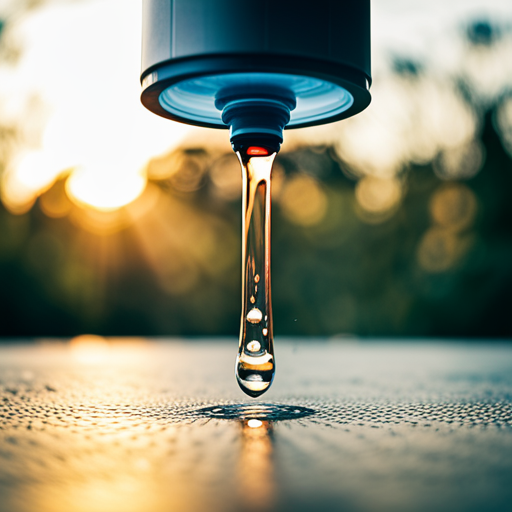Looking for a solution to the microplastics that are contaminating your drinking water? Look no further than reverse osmosis.
Microplastics are tiny particles of plastic, less than 5mm in length, that have contaminated 92% of all tap water and 93% of bottled water. This has led to concerns about their adverse health impacts, including obesity, diabetes, heart disease, cancer, neural disorders, and reproductive problems.
Fortunately, reverse osmosis is the most effective way to remove microplastics from your drinking water. This process uses a semipermeable membrane to remove impurities, including microplastics, from your water.
Activated carbon filters and sediment filters are also effective, but reverse osmosis is considered the gold standard for removing microplastics.
In this article, we will explore the magic of reverse osmosis and its effectiveness in removing microplastics from your drinking water.
Key Takeaways
– Microplastics are a significant contamination issue in drinking water, with 92% of all tap water and 93% of bottled water being contaminated.
– Experts are concerned that consuming microplastics can cause adverse health impacts such as obesity, diabetes, heart disease, cancer, neural disorders, and reproductive problems.
– Reverse osmosis is the most effective method for removing microplastics from drinking water, followed by activated carbon filters and sediment filters.
– The average American consumes between 39,000 and 52,000 microplastic particles each year, which may also transport harmful diseases and absorb other pollutants.
What are Microplastics?
You already know that microplastics are tiny pieces of plastic less than 5mm long that are found in 92% of all tap water and 93% of bottled water. These harmful substances originate from larger plastic items like bottles, clothing, and other trash that break down over time into smaller pieces. This process is known as degradation, and it’s a significant source of microplastics in our environment.
Contamination of drinking water with microplastics is a severe issue that has adverse health impacts like obesity, diabetes, heart disease, cancer, neural disorders, and reproductive problems. Moreover, microplastics may serve as transportation vehicles for harmful diseases such as bacteria, viruses, and parasites.
Additionally, microplastics may absorb other pollutants that then enter our bodies when we drink water contaminated with microplastics. Therefore, it’s essential to understand the sources and contamination of microplastics to comprehend the significance of removing them from drinking water.
Health Impacts and Concerns
Experts are concerned about the potential adverse health impacts of consuming tiny plastic particles that can contaminate drinking water. While the full extent of these health risks is not yet known, studies have shown that microplastics can absorb other pollutants, such as endocrine disruptors, which may have a detrimental impact on animal fertility and human health.
Additionally, microplastics can serve as transportation vehicles for harmful diseases, such as bacteria, viruses, and parasites, increasing the risk of illness for those who consume them.
The environmental impact of microplastics is also a significant concern. These tiny particles can harm aquatic organisms, causing damage to digestive tracks and stunting growth.
As we consume contaminated water, we inadvertently become part of the problem, potentially contributing to the further spread of microplastics and the pollutants they carry.
As such, it’s crucial to invest in effective filtration methods, like reverse osmosis, to remove microplastics from drinking water and reduce the risk of adverse health impacts on both humans and our environment.
Effectiveness of Reverse Osmosis
When looking for a reliable and effective method to remove tiny plastic particles from your drinking water, it’s important to consider the benefits of using a reverse osmosis system. Reverse osmosis is a membrane technology that works by pushing water through a semipermeable membrane that traps contaminants, including microplastics. This process is highly effective and can remove up to 99% of microplastics from your drinking water.
However, it’s important to note that reverse osmosis can also remove minerals and other beneficial substances from water. This can be solved by adding a remineralization filter after the reverse osmosis system to replace the minerals lost during the filtration process. Overall, reverse osmosis is a reliable and effective method for removing microplastics from drinking water while maintaining its safety and quality.
| Pros | Cons |
|---|---|
| Highly effective in removing microplastics | Removes minerals and other beneficial substances |
| Easy to install and maintain | Requires electricity to operate |
| Can be used for both residential and commercial purposes | Wastes water during the filtration process |
| Provides safe and clean drinking water | Additional cost for remineralization filter |
Conclusion
Congratulations! You now know how reverse osmosis can help you remove microplastics from your drinking water.
You have learned that microplastics are tiny pieces of plastic less than 5mm long, and they are present in our environment due to the breakdown of larger plastic items. These microplastics have contaminated 92% of all tap water and 93% of bottled water, leading to concerns about their adverse health impacts.
However, the good news is that reverse osmosis is the most effective way to remove microplastics from drinking water, followed by activated carbon filters and sediment filters.
So, if you want to ensure that your drinking water is free from microplastics, you should consider investing in a reverse osmosis system. By doing so, you can protect your health and the health of your loved ones.
